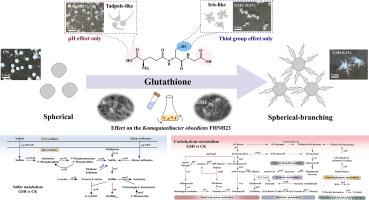通过谷胱甘肽引导合成的新型球形分枝细菌纤维素生物材料
IF 12.5
1区 化学
Q1 CHEMISTRY, APPLIED
引用次数: 0
摘要
细菌纤维素(BC)由于其独特的纳米结构和优异的物理化学性质而成为一种很有前途的生物材料。本研究通过谷胱甘肽(GSH)介导的生物合成,成功合成了一种新的球形分支BC结构,分支的长度和数量受谷胱甘肽浓度的调节。适当的谷胱甘肽补充改变了BC的微观形态和晶体结构,包括纤维直径的减少,从棒状细菌细胞到球形细菌细胞的形态转变,结晶度的增加。通过对照实验和转录组学分析,系统研究了谷胱甘肽(GSH)对komagataebacter oboediens FHNH23培养环境和生理状态的影响,进一步阐明了其在BC合成和组装中的作用。本研究首次开发了一种可控的球支BC材料,揭示了谷胱甘肽调控BC结构的机制,为纤维素材料的生物合成调控提供了创新见解,为环境、生物医学等相关领域的新材料定制开发提供了坚实的理论基础和实践指导。本文章由计算机程序翻译,如有差异,请以英文原文为准。

A novel spherical-branching bacterial cellulose biomaterial synthesized via glutathione guidance
Bacterial cellulose (BC) has emerged as a promising biomaterial due to its unique nanostructure and exceptional physicochemical properties. In this study, a novel spherical-branching BC structure was successfully synthesized through glutathione (GSH)-mediated biosynthesis, and the length and number of the branches were shown to be modulated by GSH concentration. Appropriate GSH supplementation altered the microscopic morphology and crystal structure of BC, including a reduction in fiber diameter, a morphological transition from rod-like to spherical bacterial cells, and an increase in crystallinity. Through controlled experiments and transcriptomic analysis, the effects of GSH on both the culture environment and physiological state of Komagataeibacter oboediens FHNH23 were systematically investigated, further clarifying its role in BC synthesis and assembly. In this work, a controllable spherical-branching BC material was first developed, and the mechanism by which GSH regulated the BC structure was revealed, which provided innovative insights into the biosynthetic regulation of cellulose materials and offered a solid theoretical foundation and practical guidance for the tailored development of new materials in environmental, biomedical, and related fields.
求助全文
通过发布文献求助,成功后即可免费获取论文全文。
去求助
来源期刊

Carbohydrate Polymers
化学-高分子科学
CiteScore
22.40
自引率
8.00%
发文量
1286
审稿时长
47 days
期刊介绍:
Carbohydrate Polymers stands as a prominent journal in the glycoscience field, dedicated to exploring and harnessing the potential of polysaccharides with applications spanning bioenergy, bioplastics, biomaterials, biorefining, chemistry, drug delivery, food, health, nanotechnology, packaging, paper, pharmaceuticals, medicine, oil recovery, textiles, tissue engineering, wood, and various aspects of glycoscience.
The journal emphasizes the central role of well-characterized carbohydrate polymers, highlighting their significance as the primary focus rather than a peripheral topic. Each paper must prominently feature at least one named carbohydrate polymer, evident in both citation and title, with a commitment to innovative research that advances scientific knowledge.
 求助内容:
求助内容: 应助结果提醒方式:
应助结果提醒方式:


